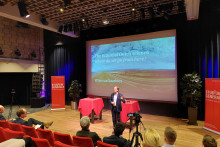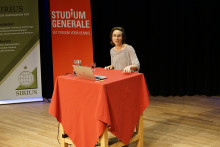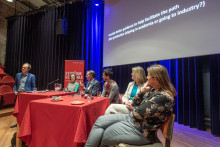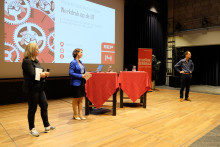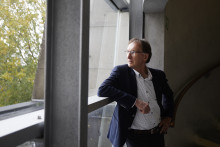Van Saarloos begins his lecture by explaining the development of science in the decades after the Second World War. ‘The first fifteen years after the war were a kind of exponential growth phase in budget spending for Dutch universities.’ After 1960, however, the budget for research grew very slowly, he described.
An interesting transition took place in the early 2000s when ‘the government began to focus more on application, knowledge transfer and reaching out to new students’, Van Saarloos mentioned. In this new transition phase, ‘there was also a huge increase in students’. In summary, universities in the Netherlands ‘have been confronted with more tasks since 2000, but are financed with a budget that did not grow proportionally.’
Strengths and weaknesses
Van Saarloos went on to pinpoint the weaknesses of Dutch science, like the underrepresentation of STEM (science, technology, engineering and mathematics) disciplines compared to other countries. And according to Van Saarloos, government spending on research is also an issue: 'The Netherlands spends 2% of its gross national product on research and development, while other European countries like Denmark and Germany spend up to 3%.’
However, Van Saarloos argues that Dutch research 'is extremely efficient with little investment'. According to Saarloos, this is due to the cooperation between thirteen almost identically strong universities and the Dutch ‘polder culture’. shortcoming of Dutch science is that 'the separation between technical and general universities is greater in the Netherlands than in most other countries'. This leads to a 'natural divide between technical and general universities in the Netherlands, which makes it difficult for universities to research important and complicated topics such as the climate and energy transition'.
Instability
Moreover, Van Saarloos sees that ‘a lot of money is needed for education to train more students, while less money is spent on basic research’. In this context, he repeatedly criticised the high number of students enrolling in Dutch universities. On top of that, he mentioned that the funding system does not support continuity and stability, as the funding system for research in the Netherlands is ‘characterised by sudden increases and decreases in investment’.
This instability of funding makes it difficult for researchers who want to do long-term research on different scientific topics, said Van Saarloos. This leads to universities in the Netherlands 'not wanting to invest in certain research because funding can change at any time'. He thinks that ‘The Dutch science system has reached the end of its possibilities and is hence in transition to a new system.’
Recommendations
As the old Dutch science system is coming to an end, Van Saarloos believes it is important that he makes proposals for the new science system of the Netherlands. That’s why he came up with twenty recommendations, varying from a Chief Scientific Advisor to ‘rolling grants’. The first of his suggestions for improving science is to reduce instability in funding science, as instability ‘is bad for science, you need some continuity in research, which requires vision in funding’. This would mean that the Dutch government should avoid sudden budget cuts and increases.
To further improve the quality of Dutch science, he believes that 'the idea of funding education at the expense of research needs to be rethought'. Furthermore, Van Saarloos believes that ‘we should remove barriers between engineering sciences and the other fields’ – more specifically, the ‘historically created’ divide between technical universities and general universities. ‘This would enhance the ability to collaborate with scientists from different fields on complex issues such as climate change.’


